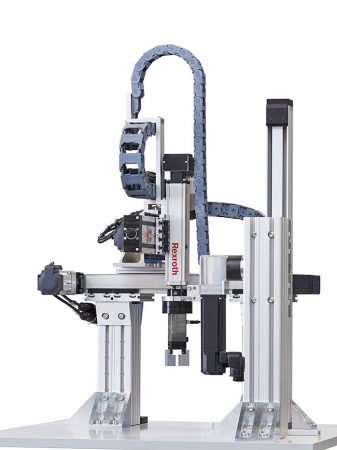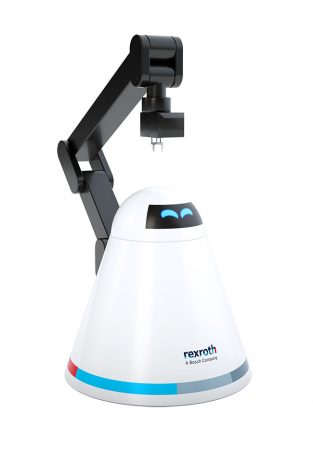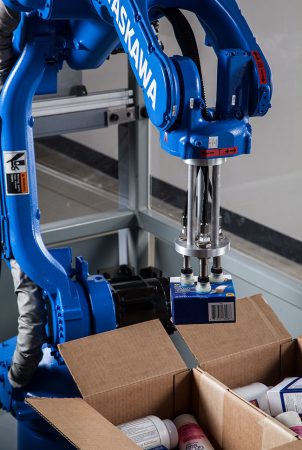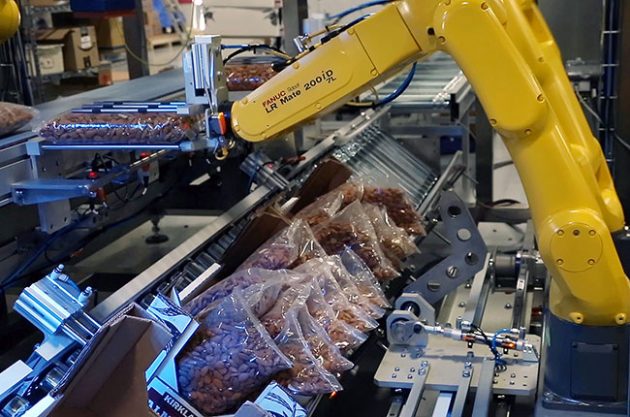
On the edge of the robopocalypse
George Guidoni
Automation Case Packing Motors Palletizing Robotics ABB Robotics APAS Assistant Bosch Rexroth Canada Corp. Cartesian FANUC FlexPicker Inc. Industry 4.0 LOSTPED Loup Ventures Nuspark Inc. Propack Processing and Packaging Systems Yaskawa America Yaskawa Electric Corporation Yaskawa Motoman YuMiSurging demand for packaging line robots part of widespread industry drive for optimized packaging automation
The only thing capturing the essence of packaging automation better than a robot performing a repetitive, dangerous or mundane task at breathtaking speeds is seeing that robot doing the same thing 24 hours a day, 365 days a year, with perfect precision and consistently reliable outcome.
For many packaging line operators in today’s globalized CPG (consumer packaged goods) industries, the question of whether to install robots to automate their pick-and-place, denesting, boxing, palletizing functions with stand-alone robot arms or integrated robotic workcells has become largely rhetorical.
Having overwhelmingly bought into the notion that robotics offer one of the most reliable pathways to manufacturing competitiveness and cost control, CPG companies large and small are investing vast sums of money into outfitting their manufacturing lines with increasingly faster, nimbler and more affordable industrial robotic systems to boost productivity, safety and bottom-line results.

Cartesian robots, which are also sometimes called Gantry robots, use motors and linear actuators to position the robotic tooling in X, Y & Z directions.
In fact, calling robotics a high-growth market could be considered a timid understatement in the context of many industry forecasts painting a picture of an explosive boom with virtually limitless upward potential.
According to data from Loup Ventures, the world market for industrial robots is expected to surge to US$33.8 billion by 2025—nearly tripling from US$12.3 billion in 2016 despite notable price declines for many types of robots during the projected time period.
While a good portion of that boom will be driven by rapid sales of new-generation collaborative robots—designed to work alongside humans without protective guarding or enclosures—the sales of more traditional Cartesian (gantry), SCARA (Selective Compliance Articulated Robot Arm) and delta (parallel) robots are also poised for exceptional growth.
For the world’s leading industrial automation companies, having their own brand robotics systems as part of their product portfolio is fast a becoming a norm, rather than exception.
Operating in Canada since 1961, Bosch Rexroth Canada Corp. only stated to market its own brand of Cartesian robots as part of integrated CMS (control motion system) automation solutions that also incorporate Bosch Rexroth motors, drives, controls and pneumatics in addition to the three core X, Y and Z linear axes.
“Prior to that, we were mainly focused on components and kits for our customers to put together,” says Bosch Rexroth Canada’s business development manager Asvin Parsad.
“But with evolving consumer market demand, our customers needed to become more flexible, faster-to-market and more productive, while reducing costs,” says Parsad, describing his company’s three-axis robots
as “a compact, scalable and economical alternative where an articulated robot would have been less suitable.”

Scheduled for commercial launch next year, the APAS Assistant is a collaborative robot that can work with humans without a safety fence.
As Parsad explains, “Our CMS robot was designed with material handling in mind, to fit strict envelope restrictions.
“It had to be scalable to accommodate for long reaches and high payloads, while maintaining its tight rigidity throughout the work area,” says Parsad, stressing the importance of selecting the right robot for the
right application from the outset.
“The most common pitfall is failing to correctly evaluate the application needs,” Parsad states, citing the so-called LOSTPED profiling parameters of the job’s load, orientation, speed, travel, precision, environment and duty cycle.
“From there we can determine what type of robot is best suited for the job, the size, configuration and payload.
“For example, a load of 50 kilograms would be on the upper end of an articulated robot and cause it to wear out prematurely and lose positioning accuracy, as the end of arm is moves away from the pedestal.
“The Cartesian robot can easily pick up a similar mass a repeatedly position it within 10-μm (micrometer) of accuracy,” Parsad states.
“On the other hand, an articulated robot has a higher range of motion and can reach down from under a conveyor and place a part on another plane with ease,” Parsad points out, “which is not easily done with a
Cartesian system.”
With Bosch Rexroth now ranking as one of the Top Three manufacturers of Cartesian robots in the world, the company offers its systems in three levels of architecture depending on the user’s robotics expertise.
“It start with the basic mechatronics system (basic level), which we can expand with the servo drives (comfort level), and then add the high-performing motion logic control system (advanced level), with pre-defined functions for the common handling applications,” Parsad relates.
According to Parsad, Bosch Rexroth’s success in industrial robotics is rooted in the company’s focus on “fast and easy and fast assembly, thanks to direct connection and pre-fabricated assemblies; positive-locking
connections; weight-optimized design; and a broad spectrum of combination options.
“For customers, that translates into reduced installation effort that saves time and money,” Parsad points out, “along with high accuracy, durability, and reproducibility, without having to make finicky adjustments.”
Adds Parsad: “We made the decision back in 2013 to open up our motion control and drive functions, so that users could connect our controller to the outside world through our Open Core Interface [and] access the motion logic directly through their preferred development environment without writing a single line of PLC code.
“With the web-based tools for selection design, the attachment options and the positive locking mechanism and start up wizard, our customers are able to save up to 70 per cent on their engineering, 60 per cent on installation, and 90 per cent on the startup time.”
Parsad reveals that Bosch Rexroth is planning to launch the second generation of the CMS robot later this year, which will feature expanded configuration options, higher payload and new web-based tool for system design and sizing.
As for growing popularity of collaborative be robots, the company has high hope for next year’s launch of its APAS Assistant robot, according to Parsad.
“It is a collaborative and intelligent robotic system for the direct, safe and contact-free collaboration of humans and machine without a safety device,” Parsad explains.
“It is designed to support human operators with simple and monotonous tasks to optimize the manufacturing process, even at small batch sizes.
“Equipped with a highly sensitive ‘sensor skin,’ the system responds the moment an employee approaches it.”

A high-speed Yaskawa Motoman robot outfitted with suction end effectors makes light work of packing shipping containers to maximum filling capacity with different package types and shapes.
For its part, the venerable Japanese-headquartered industrial giant Yaskawa Electric Corporation can trace its robotic roots back to 1977, when it launched its very first electric industrial robot.
Today, the company bills itself as the as the world’s largest industrial robot company with a global footprint, with its Yaskawa Motoman division employs thousands of people on a global basis to manufacturing,
sell and supporting its extensive industrial robotics product portfolio.
“Industrial robots are a perfect extension of Yaskawa’s highly successful business in the servo motion control market space,” says Dean Elkins, segment leader for material handling at the Motoman Robotics
Division of Yaskawa America, Inc.
“Yaskawa has emerged as the industry leader in robot innovation and volume,” says Elkins, citing thousands of successful installations of the company’s the articulated, delta, SCARA packaging robots automating
countless picking, packing, and palletizing applications all over the world.”
According to Elkins, Yaskawa Motoman is keen to establish a leading market positions in the emerging new trends in the robotics sector, which include the deployment of collaborative robots, Industry 4.0 machine-to-machine communication and data acquisition, robot mobility, and machine vision.
“We are leading the charge in all these areas and have designed our products and organization to be applicable to them, while providing world class support to our customers,” he says, adding the company likes to wok closely with all its clients to help them achieve greater machine efficiency, greater throughput, acceptance of automation by user employees, and the meeting of ROI (return-on-investment) objectives.
Says Etkins: “Yaskawa’s innovative roots are well demonstrated in our robot designs in the packaging space.
“Our programming languages are geared to be highly flexible to allowing for implementation without the need for high degrees of training,” Etkins explains, “while our open source interfaces allow for easy interfaces with many of the sensors required in packaging, along with pendant applications exist to accommodate the simple interfacing of several third-party end effector designs.”
According to Elkins, the company offers both direct integration support as well as a global network of highly skilled and qualified network of systems integrators and OEM (original equipment manufacturers to provide solutions for virtually any packaging automation challenge.
“Yaskawa is experiencing great growth in the food and beverage, and snacks and confectionery spaces,” Elkins observes, “and utilization of robotics in packaging applications is predicted to be one of the fastest growing segments in automation over the next five years.
“Our broad product line, ease of interfacing and programming, and customer support speak volumes in terms of our value proposition.”
For packaging OEMs like Nuspark Inc. in Toronto, robotics have become a much more common feature on the company’s customized end-of-line-packaging solutions that include cartoning, case-packing, palletizing, tray-packing/forming and top loading workcells in recent years.
“Integrated robotics are an integral part of our solutions,” says Nuspark’s head of marketing Dan Ellent.
“The growing demand for lighter high-speed robots has lead to interesting new offerings which we have been able to integrate to benefit of our customers,” says Ellent, citing the company’s status as an official
integrator of the FANUC range of robots.
While Ellent says the company is capable of integrating robots from other manufacturers if so required by the customer, FANUC robots generally provide the sufficient speed and reliability for the systems and applications that Nuspark specializes in.
For these reasons, Nuspark is currently taking a wait-and-see approach to the collaborative robots, despite their compelling early mass appeal.
“Collaborative robots seem to be a general trend,” Ellent acknowledges, “but we have not yet found the right application for them as they are generally slower than our applications require.
According to Ellent, the current generation of industrial robotics is still not a match for human intelligence on the plant floor, despite all the rapid technological advances in recent years.
Says Ellent: “One of the major pitfalls is the expectation that robots can think or manipulate on a near human level.
“So although we are approaching near-human manipulation capabilities, we still have a way to go before robots rival humans in terms of their ability to receive input and make decisions,” he says.
“Once customers understand the limitations of vision and robotics systems, it becomes a lot simpler to plan for, and achieve a realistic goal in the form of an automation solution that provides minimum operator intervention, decreased downtime, and increased overall throughput.”

A custom-designed packaging sell manufactured by Nuspark employs high-speed FANUC pick-and-place robots to load large bags of almonds inside display tray formed on the same machine.
For Propack Processing and Packaging Systems, Inc., manufacturer of high-speed horizontal from-fill-seal (HFFS) machinery for the baked goods industries, the high throughput rates enabled by robotic pick-and-place systems at the core of the company’s value proposition to its end-use customers, according to company president Chris Follows.
“Without robotics we would not be in business,” says Follows, who has headed the Beamsville, Ont.-based Propack since 1998.
As an authorized integrator for ABB Robotics in Canada, Propack was the first company in Canada to install and integrate ABB’s famed Flexpicker brand pick-and-place robot on one of its earlier systems.
“We are one of the largest users of ABB robots in Canada,” says Follows.
“We don’t make and secondary packaging machines that would not feature a robot in them.
“Robotics give provide the flexibility and the speed we need in our applications,” says Follows, citing the company’s expansive range of packaging solutions featuring single-, double-and triple-infeed and other high-speed machines packing products in lay-flat and on-edge orientations at rats of up to 600 items per minute.
“We have our equipment installed at every major granola bar manufacturer in Canada,” says Follows, “but we also do a lot of work in the U.S., Mexico and South America.”
“The world’s biggest manufacturer of granola bars in the world, located in the U.S.,” has 54 of our machines installed at its main production facility,” Follows points out.
For his parts, Follows finds collaborative robots to be a “very interesting’ technology that may well find its use in more packaging applications than people thing right now.
“I truly believe that collaborative robots are the way of the future,” he says, “and we are continually looking at ways that we can incorporate them into our product offerings.”
Says Follows: “It seems like a very good solution for environment where you would not want to be human operators to spend a lot of time—like the cold-room, for example.
“In situations like that, a collaborative robot makes lot of sense,” says Follows, citing the versatility of ABB’s YuMi collaborative robots that can be now mounted either horizontally or vertically.
“Because a collaborative robot does not require protective fencing, it can decrease the sanitation costs quite significantly in the bakery industry applications,” Follows point out.
All in all, Follows says that packaging robots have come a long way in his 25 years in he business in terms of reliability, standardization of components, payload capacity and conveyor tracking capabilities.
“You don’t really have so many dedicated production lines like we used to with the mechanical systems in the old days,” Follows states.
“Today your line may need to be changed over four to five times per days, which is where the flexibility of robots is so ever important,” he states.
“It is not uncommon to see our machines, which have a 25-year duty cycle, to be used to pack four or five different products over their life-span,” Follows states.
“I really don’t see how this would have been possible without the reliable and well-designed robotic systems that we incorporate in our equipment design.”
Advertisement

